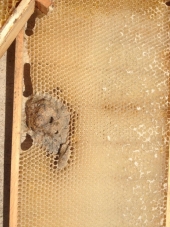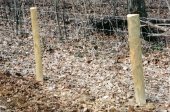

Jerry Ward wrote:Hello,
I live in S.E. MI and have 10 acres of mixed grass, brush and trees. I have some areas that I cleared the end of last year and am wondering what I can plant that will help bees this year. I'm getting a package in a week or so.
I do have some White Dutch Clover seed that I will be throwing down, but any other advice would be helpful.
Thanks,
Jerry

Natasha Turner wrote:We have a plethora of beetles in our hive right now. It has just been moved from a farm about 20 miles away. Most likely, the bees were stressed for a few days, because we had a makeshift entrance reducer on during the move that we were nervous to pull fully off. The bees were extremely active after the move, in the middle of the night. Hubby pulled off as much as he could and took off running. A day later, he went to see about pulling it out again, but they were still very active. Two days after that, when he was away at work I heard the bees very loudly from far away and upon approaching noticed they were in a columnar form from the hive to the top of the tree above them.
I thought they were swarming, so I manned up and got geared up to check the bees myself, for the first time ever. When I pulled away the shirt [makeshift entrance reducer], the folds were filled with beetles. Some ran back into the hive, others dropped to the ground. I tried to research what to do, but the opinions are so mixed that I finally went with the opinion of letting the bees deal with it themselves (since I had at least gotten our mess out of the way).
Was this a good way to "deal" with it? Should I do more? They are considerably calmed down now. There are active bees still there. I don't think I have the guts to open the hive myself. Would it change anything?
Seeking more knowledge than I have . . .


Nicholas Heindl wrote:Do you prefer traditional or top bar hives? Is one better to prevent CCD than the other?

david tyler wrote:Hello Christy
Thank you for your time and sharing your knowledge.
I am curious as to the pesticides that they are claiming to be responsible for CCD, are these chemicals that are killing the hives off making it in to the honey supply therefor being consumed by the public?


Jude Calhoun wrote:hay,
another beekeeper i know is having issues with his Langstroth hives, and i need to help him if i can. he sent me some photographs of the abandoned comb, which i've attatched below. i've got more photos if you'd like to look at them for more evidence of the issue.
in one hive, there seems to be a papery nest of some sort in the lower middle part of three frames. he hasn't seen any non-honeybee critters emerging from it. doesn't look like a wasp's nest, but maybze it's another bug? or some kind of mould??? we don't know when the bees ghosted, or when this nest thing appeared (so it could have been after they left or something)
the second hive, and this one I'm real nervous about, could be a virus of some kind that i haven't had personal experience identifying. when he opened the hive to check 'em, the bees were gone. even though they were a relatively new colony (about a year old), their comb was very dark. he is afraid it's American Foulbrood, and did the 'toothpick test' in some cells, but when he pulled the toothpick out of the cells, the tip wasn't brown or nasty or gooey. WHEW. So. what could it be?
He's located in Scranton, near Florence, South Carolina, and doesn't have much free time to be part of beekeeping groups down there, or be a mentee to any more experienced keepers.
ya'll were the first forum to come to mind when i thought about posing this question, and i felt it was high time i became part of the forums. also, it'd be real cool if i got a chance to receive a free copy of Christy Hemenway's book, The Thinking Beekeeper. cuz' i'm definitely thinking, and sharing those thoughts with novice bee enthusiasts (who are in turn sharing their strange thoughts with me) around richmond. there's a real movement buzzing here!
i'd appreciate any help with this, the dewd is becoming discouraged, and i don't want him to lose hope or give it up, cuz it's very very important to his mental/spiritual/everything wellbeing, and he's been having a tough go at it the last couple of years.
thanxx!
hi-5s & honey,
-jude

Deb Stephens wrote:Welcome Christy!
I have a two-part question for you...
We have considered trying to raise bees on our homestead for years, but always decided against them because we were afraid they might out-compete native pollinators for the same resources. However, with so many of the pollinators -- native or not -- falling victim to environmental degradation, disease, etc. maybe ANY bee is better than none? Also, I do wonder if the thinking about competition between natives and introduced bees is not something of a myth anyway. It certainly seems as if there is plenty of pollen to go around. What is your opinion on that score?
Looking forward to your answer. Thanks!

Blythe Barbo wrote:Have you heard of the "false floor effect?" Any idea why it happens?
A Warre hive of ours swarmed the other day - I figured it must have been completely full of comb; however, when I opened it up to add a box at the bottom, the last box was completely empty (the top 2 were full). I have been talking with other beeks who say sometimes the bees don't want to go to the lower box. I went ahead and added an extra box anyway; I figured it would help with air circulation at this time of year. We've had one of the wettest springs on record, and moisture has been a bit of a problem. I noted some moisture collecting on the landing board at the entrance prior to the swarm, but just thought it must be because there were so many bees (more bees, more respiration - more moisture, right?) - and also figured they'd be close to swarming, but I was quite surprised to find that empty bottom box. Ideas?

Aaron Althouse wrote:I'll add another question - about predator control. We have black bears that come onto our property during apple harvest time, and I am looking to deter them. Is there any benefit to using a top bar hive as opposed to a vertical one? We're mainly using bees for pollination and don't necessarily plan to harvest their honey. Will this increase the likelihood of bear activity? What have others done?
Thanks for any insight!
-AA


Patrick Mann wrote:Adding to the original question: what size hive do you consider optimal for overwintering? I have lost several colonies overwintering in full-size top bars. Now I am thinking about overwintering in top bar nucs; or splitting a single top bar into 2 colonies for overwintering. My thinking is to reduce the amount of space that the bees need to thermo-regulate.
